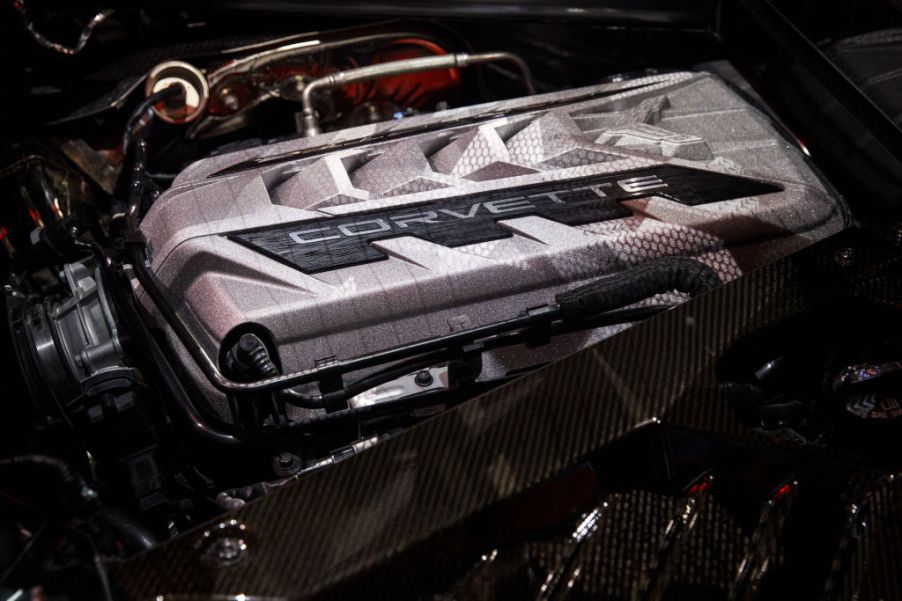
How Powerful Is the 2020 Chevrolet Corvette Stingray?
Chevrolet’s first mid-engine Corvette Stingray is here, and it’s a historic departure from 67 years of front-engine design for the supercar. According to Chevy, the 2020 Stingray is the most powerful entry Corvette.
With 495 hp and 470 lb-ft of torque, we’d have to agree that the power of the Corvette Stingray puts it in a league with supercars such as the Audi R8 and the Mercedes-AMG GT.
But what are the secrets behind the Stingray’s ability to keep churning out torque at an astonishingly high rate of speed? And just how powerful is this new C8, anyway?
We reviewed the available specs for the car to identify the components and qualities that give this new ‘Vette its incredible power. Here is what we found out.
Big displacement
Measured in cubic inches or cubic centimeters, displacement is the size of the engine internally. It is a determining factor in a car’s horsepower and torque. Displacement is calculated from cylinder diameter (the bore), piston traveling distance (the stroke), and the number of cylinders.
Increased displacement means that the car burns more gas during each revolution of the engine, which provides it with more energy to produce torque. The higher the displacement, the more power a car has.
The Stingray uses a Chevy’s small-block V8 engine that has 6.2 liters or 376 cubic inches area in the engine that can be filled with fuel and air. Combined with its eight cylinders, the Stingray’s displacement is sizeable compared to, say, the Mercedes-AMG GT’s 243 cubic inches.
High compression ratio
In an internal combustion engine, the air/fuel mixture is compressed before ignition. The compression ratio is the degree to which this mixture is compressed.
A higher compression ratio is another way for a car to increase power. This is because more compressed air results in more fuel burned for each revolution of the engine.
The Stingray’s power is boosted by its impressive 11.5:1 compression-ratio pistons. By comparison, the Mercedes-AMG GT has a compression ratio of 10.5:1.
Adding and cooling air in the cylinder
Squeezing more air—with its accompanying fuel—into each cylinder results in more power, without requiring more fuel for combustion. This works the same way as increasing cylinder size. Turbochargers and superchargers stuff more air into engines by pressurizing it.
Twin turbochargers on the Stingray do the job to cram more air into the naturally aspirated V8, thus giving it more power. To further boost the power, Chevy uses an intercooler to reduce the warm air generated from the turbochargers.
Cooler air means that the cylinders won’t expand as much during combustion, making them work more effectively. Chevy won’t say what kind of intercooler it is, but it’s probably not a traditional front-mounted one, due to the mid-engine design.
Better breathing for the car
It’s becoming clear that at least some of the Corvette’s power relies on the different ways its engine handles air. Air resistance reduces engine power when the piston moves down in the intake stroke. The way to solve this problem is to put two intake valves in each cylinder, which Chevy has done with the Stingray.
This year’s Corvette also has a new intake manifold with equal-length runners that is mounted so that the engine breathes from the back of the car. This positioning improves airflow by shortening the distance between the throttle body and the intake valve. And better airflow equals more power.
And the Stingray has large side air intakes that help lower the temperature of air coming into the engine as well.
Precise fuel injection
Fuel injection enhances a car’s power because fuel injectors spray a precise amount of fuel into the intake ports of each cylinder, which balances the air/fuel mixture and makes engine combustion more efficient.
Chevy has integrated direct fuel injection into the Stingray, a computer-controlled process in which the fuel is sprayed directly into the cylinder itself. By increasing the precision of this process, Chevy has stepped up the Stingray’s power.
Optimized exhaust
The outgoing air from the cylinder is important, too. If air resistance can be reduced when exhaust exits a cylinder, the car’s power improves.
The Stingray has updated stainless steel manifolds that, like the intake manifold, have equal runners to improve performance by pushing exhaust out more evenly and quickly. Chevy has also boosted the Stingray’s power through its performance exhaust that includes a second set of flapper valves that reduce air resistance.
And even though the new Corvette Stingray has quad exhaust tips, it really doesn’t do much for the car’s power. It just makes the car look and sound awesome…as if it didn’t already.
Greater than the sum of its parts
Some refinements made to increase a car’s power are obvious, such as giving it bigger displacement. Others, like the various ways that Chevy uses to get more air into the cylinders of the ‘Vette’s engine, are more subtle and take a page from the racecar playbook.
But all of these variables magically add up to a 2020 Corvette Stingray that is both more powerful than the previous generation and more so than many cars in its class. And that, for the record, is fearsomely powerful.


